Distribution
Geum montanum is widespread in the Alps, typically at elevations in the range 1430–2300 m (though it occurs at as low as 700 m in Centovalli and as high as 3500 m in Monte Rosa). It is found in the Pyrenees, the Cantabrians, the Massif Central, the Black Forest, the Sudetes (1300–1400 m), throughout the Carpathians (900–2500 m in the Tatras), in the north of the Apennines, on the island of Corsica, and on the Balkan Peninsula: in the mountains of Bosnia and Herzegovina, Montenegro, North Macedonia, Albania, Kosovo (specifically in Žljeb and Accursed Mountains), northernmost Greece (2000–2500 m in Varnous, Kajmakčalan and Tzena), in the east of Serbia (Suva Planina) and the west of Bulgaria (at elevations of 1600–2700 m in western and central Stara Planina, Sredna Gora, Vitosha, Osogovo, Rila, Pirin, Slavyanka and the western Rhodopes). [1] [2] [3] [4] [5]

Rosaceae, the rose family, is a medium-sized family of flowering plants that includes 4,828 known species in 91 genera.

The Balkan mountain range is a mountain range in the eastern part of the Balkan Peninsula in Southeastern Europe. The range is conventionally taken to begin at the peak of Vrashka Chuka on the border between Bulgaria and Serbia. It then runs for about 560 kilometres (350 mi), first in a south-easterly direction along the border, then eastward across Bulgaria, forming a natural barrier between the northern and southern halves of the country, before finally reaching the Black Sea at Cape Emine. The mountains reach their highest point with Botev Peak at 2,376 metres (7,795 ft).
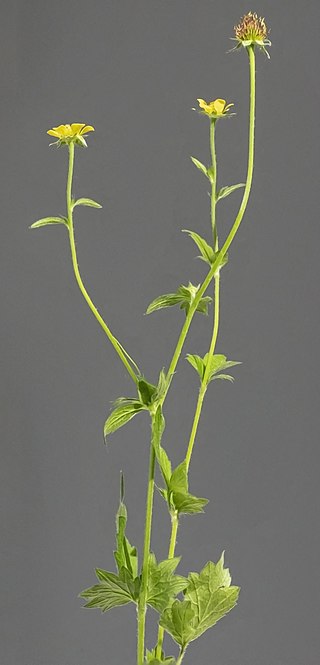
Geum urbanum, also known as wood avens, herb Bennet, colewort and St. Benedict's herb, is a perennial plant in the rose family (Rosaceae), which grows in shady places in the temperate regions of Eurasia and North America.

Peucedanum ostruthium or Imperatoria ostruthium, masterwort, is a species of flowering plant in the family Apiaceae. It is native to the mountains of Central and Southern Europe, but has been widely introduced outside its native range.
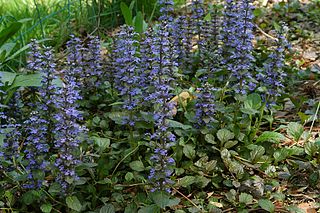
Ajuga reptans is commonly known as bugle, blue bugle, bugleherb, bugleweed, carpetweed, carpet bugleweed, and common bugle, and traditionally however less commonly as St. Lawrence plant. It is an herbaceous flowering plant in the mint family Lamiaceae, native to Europe. It is invasive in parts of North America. It is also a component of purple moor grass and rush pastures, a Biodiversity Action Plan habitat in the United Kingdom.
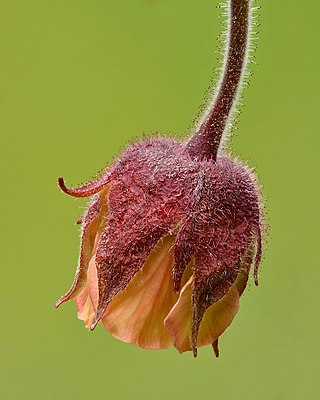
Geum rivale, the water avens, is a flowering plant in the genus Geum within the family Rosaceae. Other names of the plant are nodding avens, drooping avens, cure-all, water flower and Indian chocolate. It is native to the temperate regions of Europe, Central Asia and parts of North America, where it is known as the purple avens. It grows in bogs and damp meadows, and produces nodding red flowers from May to September.
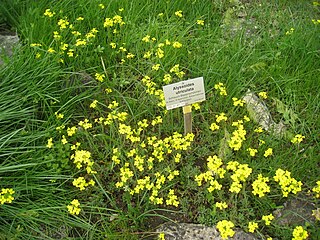
Alyssoides is a genus of flowering plants in the family Brassicaceae containing a single species, Alyssoides utriculata. A herbaceous perennial plant native to Southern Europe and Turkey, it grows on dry rocky slopes and on calcareous rocks, reaching heights of 20 to 50 cm and blooming with yellow flowers between April and May–July.

Geum bulgaricum is a species of flowering plant of the genus Geum (avens) in the family Rosaceae. A perennial herbaceous plant, it has small, bell-like yellow flowers, and is native to a few mountains on the Balkan Peninsula.

A. genevensis is a herbaceous flowering plant native to Europe. It is less common than its relative, Ajuga reptans.

Geum coccineum is a species of flowering plant in the genus Geum, in the rose family Rosaceae. Native to the mountains of the Balkans and northern Turkey, it is also grown ornamentally for its bright red flowers.

Epilobium parviflorum, commonly known as the hoary willowherb or smallflower hairy willowherb, is a herbaceous perennial plant of the family Onagraceae.

Alnus alnobetula is a common tree widespread across much of Europe, Asia, and North America. Many sources refer to it as Alnus viridis, the green alder, but botanically this is considered an illegitimate name synonymous with Alnus alnobetula subsp. fruticosa.
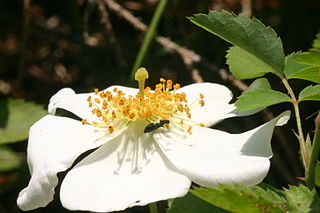
Rosa arvensis, the field rose, is a species of wild rose native to Western, Central and Southern Europe.

Rosa pendulina,, the Alpine rose or mountain rose, is a species of wild rose found in the mountains of central and southern Europe. It appears to have survived in glacial refugia in the Alps and Carpathians, and spread out from there. A climbing shrub with deep pink flowers and relatively few thorns, it has had a history of cultivation as an ornamental plant.

Rosa tomentosa, otherwise known as the harsh downy-rose, is a species of wild rose. It is a shrub growing to about 3 metres (10 ft). It is found in Asia Minor, the Caucasus, and much of Europe: the British Isles, France, Central Europe, northern Spain, Italy, and the Balkans . On the British Isles it can be found in hedgerows and woodland margins, and it typically flowers between June and July. Further south, in Bulgaria, it flowers in May.
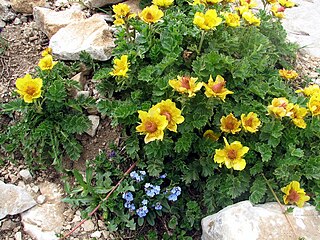
Geum reptans, the creeping avens, is a species of flowering plant in the genus Geum of the family Rosaceae native to some mountains of Central and Southeastern Europe. A long-lived perennial that reproduces both sexually and clonally, it has high phenotypic variation, but these variable traits do not appear to be adaptations to local conditions.
Geum molle is a species of flowering plant of the genus Geum (avens) in the family Rosaceae. A perennial herbaceous plant found on meadows, it is native to the mountains of the Balkan Peninsula and Italy. It blooms with yellow flowers between June and August.
Geum borisii may refer to the following plants of the genus Geum:
Alyssum minutum is a species of flowering plant in the genus Alyssum, family Brassicaceae, native to the Mediterranean and Eastern Europe.
















